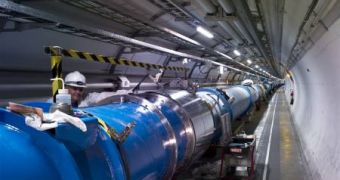Shortly after managing to fix the helium leaks that forced engineers to shut down the Large Hadron Collider (LHC) last September, project managers discovered another fluke. This time, they identified two areas of vacuum leak, in regions of the particle accelerator that needed to be cooled near absolute zero. The new damage will set back the scheduled re-commissioning date by at least two to three months, which should give engineers sufficient time to fix everything.
The reason why the new repairs will take so long is because the two areas need to be heated first, so that repairmen can near it. There is currently no way to allow the crew access in these segments at the ultracold temperatures at which they operate. According to officials at the European Organization for Nuclear Research (CERN), the owner of the LHC, the structure will be ready to accelerate new beams of particles in late November 2009, Wired informs.
Last year, when it was first announced that the accelerator was incapacitated, officials said that it would be back online by July this year. However, schedule delays and complications with the repair sequences have forced representatives to delay the estimated date to September, and then again to November. Statistics and project sheets now show that the Collider is more than two and a half years behind schedule. In 2005, a report outlined the fact that the largest particle accelerator in the world should become operational by the summer of 2007, which, obviously, didn't happen.
Each day the LHC remains offline offers more chances to physicists using the Tevatron accelerator at Fermilab, in the US, to discover the elusive Higgs boson, the particle that is believed to trigger energy into acquiring mass. Finding it would also confirm the Standard Model of particle physics, which has been able to explain a great many things until now, all relying on the fact that the Higgs exists. Its discovery would have significant implications on the world of physics.

 14 DAY TRIAL //
14 DAY TRIAL //